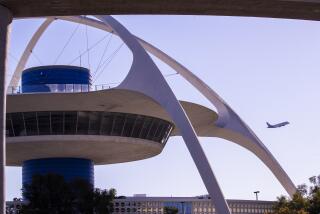Close Call at LAX Points to a Problem
- Share via
WASHINGTON — Controllers at Los Angeles International Airport were stunned this summer when an arriving jumbo jet narrowly missed a domestic flight cleared to take off on the same runway, a reconstruction showed Tuesday.
“That was close!” said an unidentified voice on the tower radio frequency, seconds after an Asiana Airlines Boeing 747, arriving from Korea, roared over a Southwest Airlines Boeing 737 preparing to depart for Albuquerque on Aug. 19, according to tapes released by the National Transportation Safety Board.
Such potentially catastrophic incidents are not being fully reported to the Federal Aviation Administration, safety board members warned at Tuesday’s NTSB hearing. The board said its staff found out about the LAX incident from the Southwest Airlines pilot, not from the FAA.
“The fact that this high-visibility close call was not reported suggests there are deeper reporting problems,” said board member Deborah A.P. Hersman.
The risk of runway collisions is considered to be the biggest safety problem facing commercial aviation as the number of flights returns to the levels seen before the Sept. 11 terrorist attacks.
Board members and staff investigators said they doubted the FAA’s assurance that the nation’s runways were slowly but surely growing safer.
“We believe the numbers [of serious incidents] are down because of a lack of reporting,” said Sandy Rowlett, the NTSB investigator who looked into the Los Angeles incident. She said the board was aware of two other recent incidents at the Cincinnati and Baltimore airports.
The NTSB has called for development of a cockpit warning system that will alert pilots when a runway is occupied by another plane. The FAA relies on radar that warns controllers in the tower but requires additional time to alert pilots.
FAA spokeswoman Laura Brown said the agency had scheduled a meeting with the safety board early next month to discuss the risk of runway accidents. She cautioned that there were no easy solutions.
“The board is looking for a silver bullet,” Brown said. “There are some technical challenges.”
She also said serious incidents were being reported. “We don’t believe there is a reporting problem with serious incidents,” Brown said.
The near collision at LAX was ultimately blamed on a controller who had just reported to work and mistakenly cleared the Southwest plane to take off from the runway on which the jumbo jet was about to land. Investigators classified it as a serious incident with significant potential for a collision.
The LAX tower did not initially report the incident because officials there believed that the two planes were not actually in danger of crashing, Rowlett said.
The safety board concluded that the episode revealed the limitations of the FAA’s tower radar. The pilot of the 747 had already taken evasive action to abort the landing before the controller gave him instructions to “go around.”
“An accident was avoided not because of [the FAA’s radar system] but because the Asiana flight crew was vigilant and saw Southwest on the runway,” Rowlett said. “If the weather had been less than perfect, or had it been nighttime, we may have had a very different outcome.”
Investigators determined that the radar system in the tower alerted controllers of a potential collision 12 seconds before it would have occurred. But it took 10 seconds for controllers to figure out the problem and order the Southwest jet to stay on the ground.
The Boeing 747, with hundreds of passengers aboard, came within 185 feet of hitting the smaller plane.
“We were very lucky on Aug. 19,” said Ellen Engleman Conners, chair of the NTSB.
More to Read
Inside the business of entertainment
The Wide Shot brings you news, analysis and insights on everything from streaming wars to production — and what it all means for the future.
You may occasionally receive promotional content from the Los Angeles Times.










